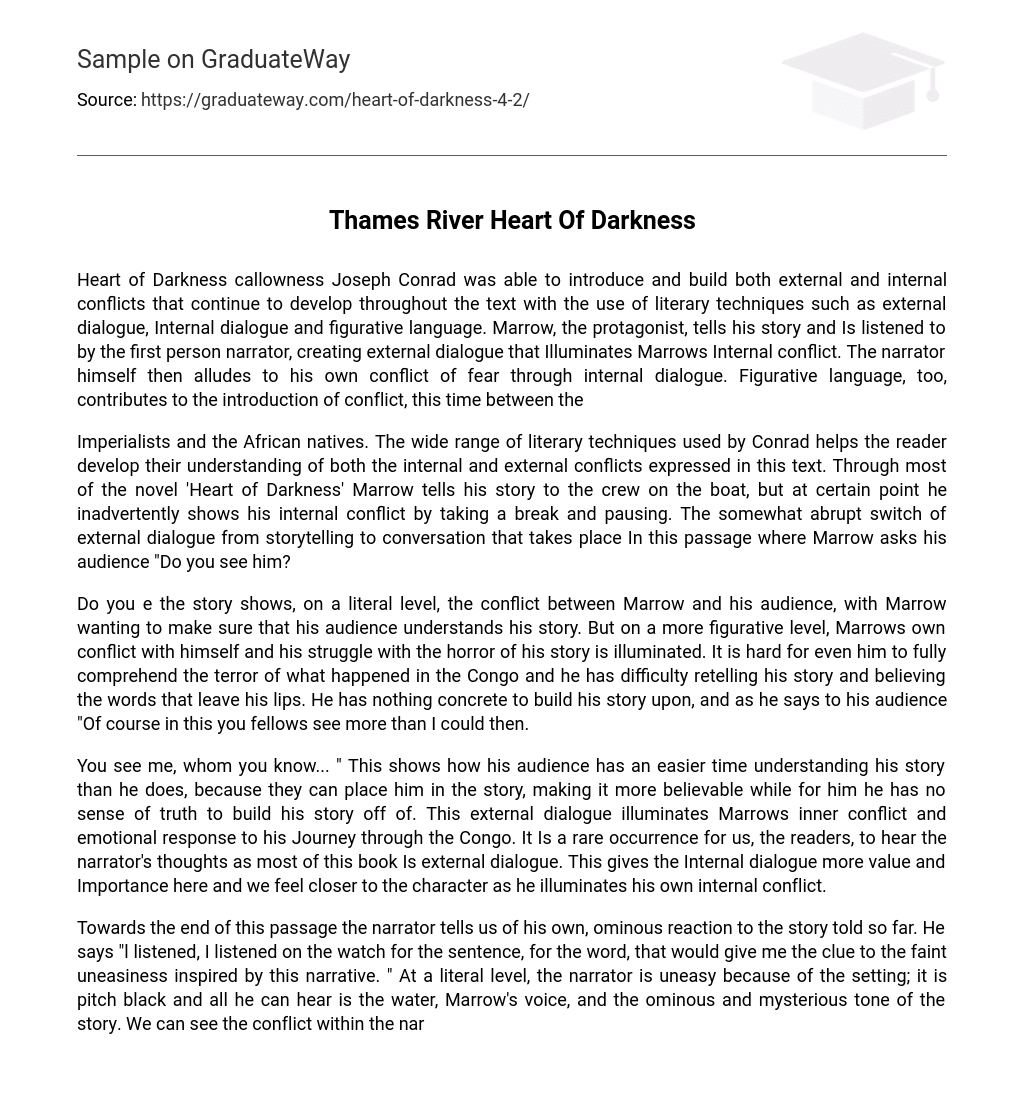Heart of Darkness callowness Joseph Conrad was able to introduce and build both external and internal conflicts that continue to develop throughout the text with the use of literary techniques such as external dialogue, Internal dialogue and figurative language. Marrow, the protagonist, tells his story and Is listened to by the first person narrator, creating external dialogue that Illuminates Marrows Internal conflict. The narrator himself then alludes to his own conflict of fear through internal dialogue. Figurative language, too, contributes to the introduction of conflict, this time between the
Imperialists and the African natives. The wide range of literary techniques used by Conrad helps the reader develop their understanding of both the internal and external conflicts expressed in this text. Through most of the novel ‘Heart of Darkness’ Marrow tells his story to the crew on the boat, but at certain point he inadvertently shows his internal conflict by taking a break and pausing. The somewhat abrupt switch of external dialogue from storytelling to conversation that takes place In this passage where Marrow asks his audience “Do you see him?
Do you e the story shows, on a literal level, the conflict between Marrow and his audience, with Marrow wanting to make sure that his audience understands his story. But on a more figurative level, Marrows own conflict with himself and his struggle with the horror of his story is illuminated. It is hard for even him to fully comprehend the terror of what happened in the Congo and he has difficulty retelling his story and believing the words that leave his lips. He has nothing concrete to build his story upon, and as he says to his audience “Of course in this you fellows see more than I could then.
You see me, whom you know… ” This shows how his audience has an easier time understanding his story than he does, because they can place him in the story, making it more believable while for him he has no sense of truth to build his story off of. This external dialogue illuminates Marrows inner conflict and emotional response to his Journey through the Congo. It Is a rare occurrence for us, the readers, to hear the narrator’s thoughts as most of this book Is external dialogue. This gives the Internal dialogue more value and Importance here and we feel closer to the character as he illuminates his own internal conflict.
Towards the end of this passage the narrator tells us of his own, ominous reaction to the story told so far. He says “l listened, I listened on the watch for the sentence, for the word, that would give me the clue to the faint uneasiness inspired by this narrative. ” At a literal level, the narrator is uneasy because of the setting; it is pitch black and all he can hear is the water, Marrow’s voice, and the ominous and mysterious tone of the story. We can see the conflict within the narrator; he fears the horror that he is being told of and it makes him uneasy.
But on a figurative level, the narrator wants to know more. The narrator says “l listened, I listened… ,” hoping to hear more. This may be Conrad reflecting on the human interest In death and horrific acts. We are Intrigued by terror and we hunger to hear more about It, causing conflict within us as we fight between listening to stories of horrific acts or staying clear of the evil and the The last literary device used by Conrad to introduce and build conflict is corrupt. Nile the man Jabbered about himself. ” The conflict shown here is between the mute forest and the oblivious Jabbering man.
In a literal sense, this shows the literal conflict between the man and nature; the forest will be difficult to enter because of the physical boundary it creates. Figuratively, this is a metaphor for the conflict between the imperialists and the natives. The forest here is described as primeval and muddy, representing the natives of Africa who are silent and have no say. The man respectively represents all imperialists who are self centered (“the man jabbered about himself”) and have vested interests only in money and do not pay attention to the voices of the natives that they have silenced.
Marrow says “l Nodded whether the stillness on the face of the immensity looking at us two were meant as an appeal or as a menace,” which further suggests conflict between the natives and the imperialists through its diction (note the usage of ‘immensity and appeal or menace,’ suggesting that the natives and the forest both appeal to the Imperialists as a source of wealth, and are a menace to them, suggesting that only trouble will come of interaction).
The both literal and figurative language used by Conrad helps us develop our understanding of the conflict between the imperialists ND the natives throughout the rest of ‘The Heart of Darkness. ‘ External dialogue, internal dialogue and figurative language are all literary techniques used by Conrad while writing ‘Heart of Darkness’ that help introduce and build both external and internal conflicts that develop throughout the text.
Marrow and the narrator deal with internal conflicts that have now been shown to us and we can see more clearly the conflict between the imperialists and the natives in the Congo. Rough the illuminated conflicts, tension and uneasiness are built and this passage ominously suggests that much worse is to come.





